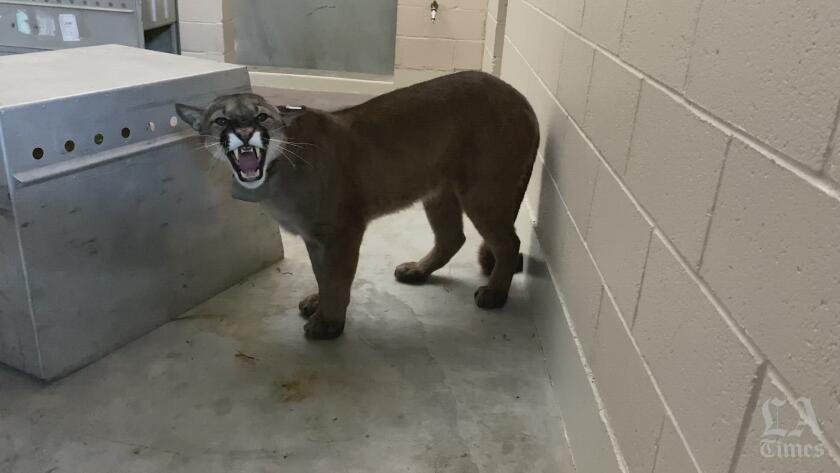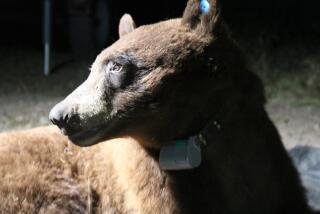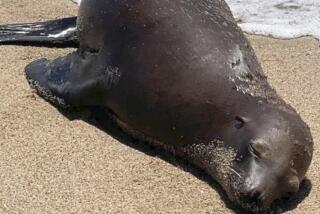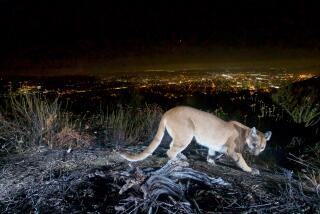Mountain lion captured alive after prowling San Francisco neighborhood for two days
SAN FRANCISCO — After lurking through a San Francisco neighborhood and alarming some residents for two days, a 2-year-old, 100-pound male mountain lion was captured Wednesday night after retreating up a tree in Bernal Heights.
Unable to make a discreet exit — as he was smack-dab in the middle of the city, surrounded by curious neighbors and gawkers — the cougar was darted by officers from California’s Department of Fish and Wildlife. They carted him over to the Oakland Zoo, where he spent the night awaiting a thorough physical evaluation.
Officials from the zoo, the state and the Bay Area Puma Project, a mountain lion research group, plan to release the apparently healthy and unharmed animal into a friendlier, undisclosed environment Thursday afternoon in Santa Clara County.
Bernal Heights is a residential neighborhood south of San Francisco’s Mission District, not the kind of semi-wild suburb where mountain lions in California frequently are spotted. This one was first reported in the neighborhood on Tuesday and had been seen a few days earlier in Pacifica — moving north along the peninsula.
How he got to Bernal Heights — away from any obvious wildlife corridor — is unclear. But Zara McDonald, director and biologist for the puma rescue group, said mountain lions visit San Francisco and other urban areas more often than many people think.
A mountain lion captured Wednesday in the San Francisco neighborhood of Bernal Heights is seen Thursday at the Oakland Zoo.
Bay Area male mountain lions generally require about 100 square miles of territory. As their natural habitat is squeezed by human development and further restricted by fires and drought, they can venture beyond their typical realm.
This cougar had been in the city at least once before, McDonald said. The Puma Project had collared him previously.
She said lions have really good internal navigational compasses, “but once they get in the city, it can become tricky.”
Such dense urban areas are stressful for them, she said. And in this case, the lion got so deep into the city, and was soon surrounded by well-meaning and curious onlookers, that it became nearly impossible for him to get out on his own.
After two days, it became clear he needed help.
That’s when the Department of Fish and Wildlife entered the scene, said department spokesman Ken Paglia, adding that state agents had been ready for a couple of days to help out San Francisco’s department of animal control, the initial responders.
As the mountain lions of Southern California approach what some experts call an “extinction vortex,” environmentalists are demanding that state officials grant the big cats protective status — a move that could potentially ban development on thousands of acres of prime real estate.
Early Thursday, the state took the lion to the Oakland Zoo, where a team of veterinarians and technicians readied themselves.
“We’re always on call, 24/7,” said Nik Dehejia, the zoo’s chief executive, citing the zoo’s 17,000-square-foot animal hospital, which he said is ready to take animals in emergency situations.
Dr. Alex Herman, the zoo’s vice president of veterinary services, said the mountain lion was “so handsome and so beautiful and so very healthy.”
She said she and her team performed a thorough examination — checking his teeth, eyes, ear, belly, heart, lungs, bladder and testicles — and provided him with some vaccinations for diseases such as feline leukemia and SIV, as well as medicines for deworming and fleas and ticks.
Almost all wild animals have some parasites, she said, but because this lion had had a few stressful days, she said, eradicating those freeloaders would ease his transition back to the wild.
Three groups — the Oakland Zoo, state, local animal control, and the Puma Project — have come together for these rescues, she noted, helping wild creatures survive.
“They don’t need to be dispatched anymore,” she said. Instead, they can be transported and released.
Erin Harrison, the zoo’s vice president of marketing, said that not all the mountain lions sent to the zoo are released back into the wild. Last summer, the staff received a young male cub from Redding whose paws had been badly burned in a fire. They performed several surgeries on the young animal. After recovering, he was transported to the Columbus Zoo, where he now resides.
Named “Captain Cal” by the fire crew that saved him, he was transported with two other orphan cubs that the zoo was caring for at the time.
In addition to fires, human encroachment and drought, mountain lions and other wild animals face threats from exposure to toxic chemicals, including rodenticides, McDonald said.
She cited a state report showing a high incidence of predators in California dying after eating rodents that have ingested anticoagulant poisons.







